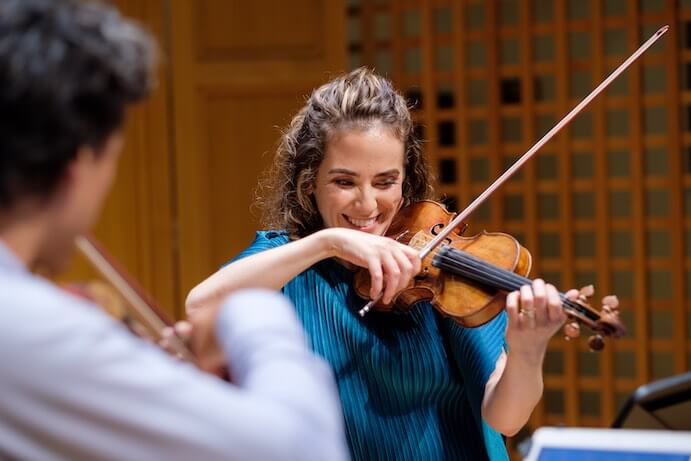Maia Jasper White is a chamber musician, teacher, and the co-Artistic Director of Salastina, an ensemble in Pasadena, California dedicated to connecting the cultural past, present, and future through chamber music. Salastina is a member of Chamber Music LA, a collective of eight local chamber music organizations with the goal of making Los Angeles the chamber music capital of the world. The ensemble’s 10th season features seven commission and world premieres. Salastina presents programs in a variety of concert formats, including a series called “Sounds Unknown,” which shares the histories behind pieces and composers neglected by the Western art music canon. This season’s “Sounds Unknown” program is titled “The Black Violin” and explores how music by Black composers and performers has not been given the recognition or credit it deserves.
How do you see Salastina’s work, and programs like “The Black Violin,” contributing meaningfully on a local level, as well as to the larger, notoriously discriminatory and inequitable world of classical music?
I love this question because it cuts straight to Salastina’s entire reason for being. We exist to reframe the idea that classical music is a thing of the past, a fairytale land, or an Ivory Tower. Our mission is “making classical music relevant to a forward-looking society.” If any of our work fails to do this, we are not living up to our mission–in other words, not doing our job.
Classical music is notoriously discriminatory and inequitable because it is a white art. Full stop. Of course, there’s nothing inherently amoral whatsoever about white European art. I’m white; I love Bach, Brahms, and Beethoven with every fiber of my being–and that’s ok! But it’s inaccurate at best to call Western Classical Music a “universal language.” And it’s amoral to deny access to said “universal language” to members of other groups. This becomes all the more problematic when touting its purported cultural superiority. Classical music’s currency is inspiration. Certainly Beethoven’s 9th and other warhorses of our repertoire are inspiring. But what really inspires me is the vast repertoire of beautiful music I never knew existed. This kind of treasure hunting more fully reveals the scope of human creativity. It’s staggering and humbling to take stock of it.
These ideas are at the heart of one of my favorite Salastina concert formats: “Sounds Unknown.” It explores the reasons why certain composers or works never achieved due recognition. Chances are, these reasons are very relatable to the world we live in today. For example: he was Black, so nobody took him seriously. He was just plain unlucky (i.e., he had the great misfortune of being a contemporary of Beethoven). She was a woman, and endured a lifetime of condescension.
All that being said: classical music has never been as exclusively white, male, or monied as one might think. “Sounds Unknown” connects musical beauty to the continuum of history in which we all live. It makes for serious brain candy. We’re so excited to be presenting “The Black Violin” in this context.

“The Black Violin” highlights Black composers and performers who were (often deliberately) erased from history. How do you untangle these rich and troublesome histories in order to share them, and why they’re important, with your audience?
With honesty, curiosity, and pathos. (And without shaming, preaching, or virtue-signaling.)
Setting a welcoming context is vital. People want to be moved, and to learn. They wouldn’t have come if that weren’t the case. And while everyone has a different perspective, they share that same curiosity. We like to think of drawing a wide circle around that point of commonality. That circle must be able to include our most conservative donor and the most progressive social justice warrior. This wide-enough circle is both a reflection of our artistic community and the moral imperative of living in a pluralistic society.
Art and the past both have a wonderful way of making current issues less threatening. Music is an abstraction to begin with, and history makes a wonderful scrim. Discussing its facts illuminates the present effortlessly, without triggering nearly as many defenses. You don’t even have to spell out how, exactly, what’s discussed connects with what’s going on today. The parallels are self-evident. There’s an art to that, and Brian Lauritzen, our resident host, is a wizard at it. Throughout “The Black Violin,” Brian will interview Derrick Spiva Jr., the composer of the concert’s premiere.

“The Black Violin” includes a premiere: Derrick Spiva Jr.’s As I Heard When I Was Young. Can you tell us what we can expect to hear with this new piece?
Derrick musically incarnates the idea of drawing a wider circle around different cultures. His wife, Kim Tran, is an ethnomusicologist. The two of them have devoted much of their creative lives to identifying what speaks to them from among the world’s many musical traditions. Derrick is particularly interested in points of commonality between musical cultures. He weaves them into a language uniquely his own. And it’s remarkably cogent. He creates a pluralistic musical utopia, complete with its own distinct culture. If it were a country, anyone would want to live there. His music is gorgeous, fun, open, and full of life.
A few years ago, he wrote a sublime string quartet for us called American Mirror. (We recorded it a year ago, and you can listen to it here.) As I Heard shares the language of American Mirror, with a heavier tilt towards the music he heard at his Black church growing up. There’s also a bass in this new piece, which provides a pretty rad, sonorous foundation.
On the first page of his score, Derrick writes: “As I Heard When I Was Young is based on the free-form instrumental and a cappella gospel blues music that I heard in churches and at home when I was child. The music I heard during this time was often highly ornamented, had a flexible yet tightly coordinated pulse among its performers, and was both melodically and harmonically dense. In this piece, these characteristics of gospel blues music are also integrated with melodic elements from Malian blues guitar music, Dagomba flute music of Northern Ghana, and the flute and percussion music of the Haha tribe of Morocco, which I began listening to as an adult… The piece highlights the deep roots of Black American gospel blues music as it relates to my personal experience, as well as my current compositional work that aims to bring diverse musical cultures together.”

You describe chamber music as the indie rock of classical music. The visceral personal and musical chemistry that draws listeners into a string quartet are the same qualities that might make IndieHeads fall in love with a White Stripes album. Is the goal of making LA the chamber music capital of the world your way of bringing more ChamberMusicHeads out of the woodwork?
In a word: yes! Making LA the chamber music capital of the world is the mission of Chamber Music Los Angeles, of which Salastina is a proud member. I like to think of CMLA as a consortium of bands. And we need a better word than ChamberMusicHeads, but I like where you’re going with that.
What has utilizing a variety of concert formats taught you about audiences and the significance of modernizing the culture around classical music?
That context is everything. I truly cannot understate this. Classical music culture is done no favors by its well-deserved elitist reputation. There’s a razor sharp line between “elevated” meaning inspired and “elevated” meaning exclusive. So long as classical music is by and for the people who championed it for most of the 20th century, it will continue to fade into obscurity.
We think of our work as audience development rather than marketing. If marketing is selling your product to people who already like your product, audience development is taste acquisition. It’s getting people to become intrigued by music they didn’t know they liked–until they do. The context all Salastina events aspire to create is one of celebration. We take so much pleasure in sharing human ingenuity and potential–two things that have been, and will always be, relevant. Sometimes, the celebration veers more towards fun (i.e., a Harry Potter-themed Halloween dinner concert). Sometimes, it veers more towards reverence (the complete string quartets of Brahms). When it comes to “The Black Violin,” the celebration is, essentially, better late than never.
























